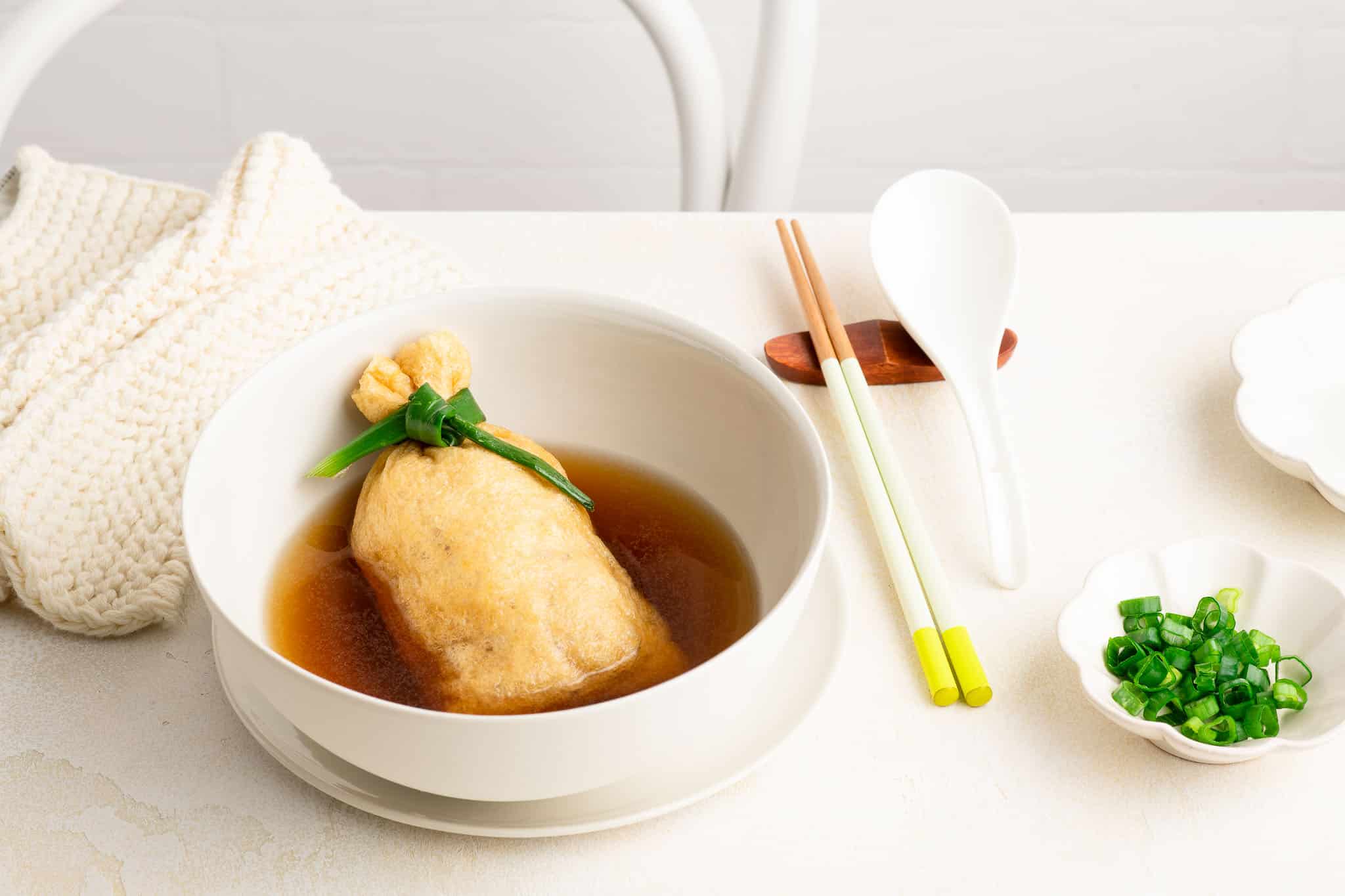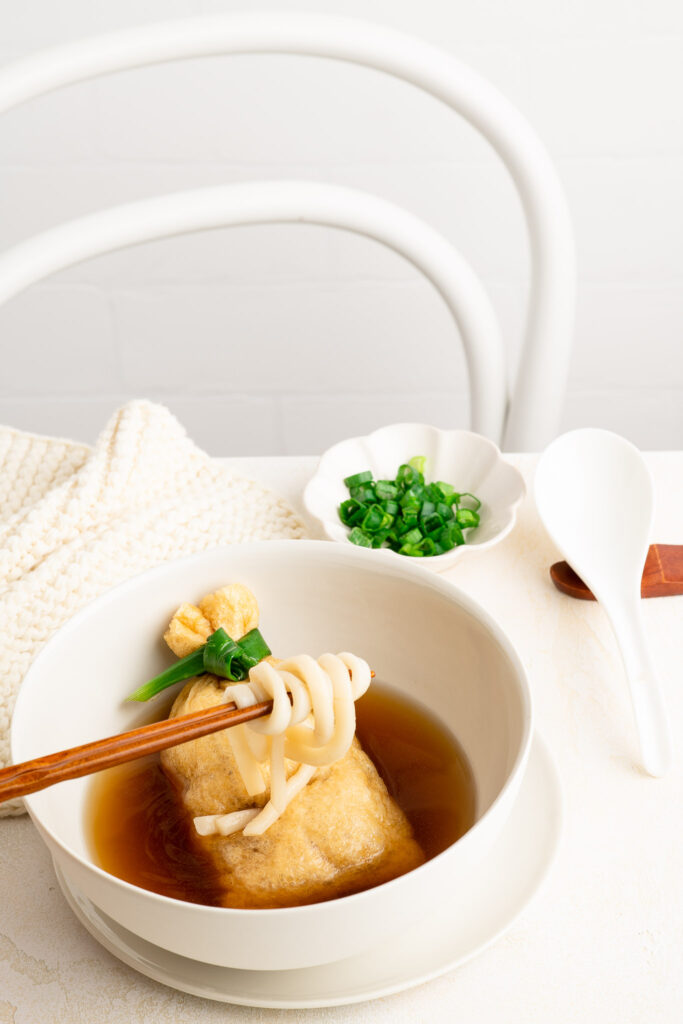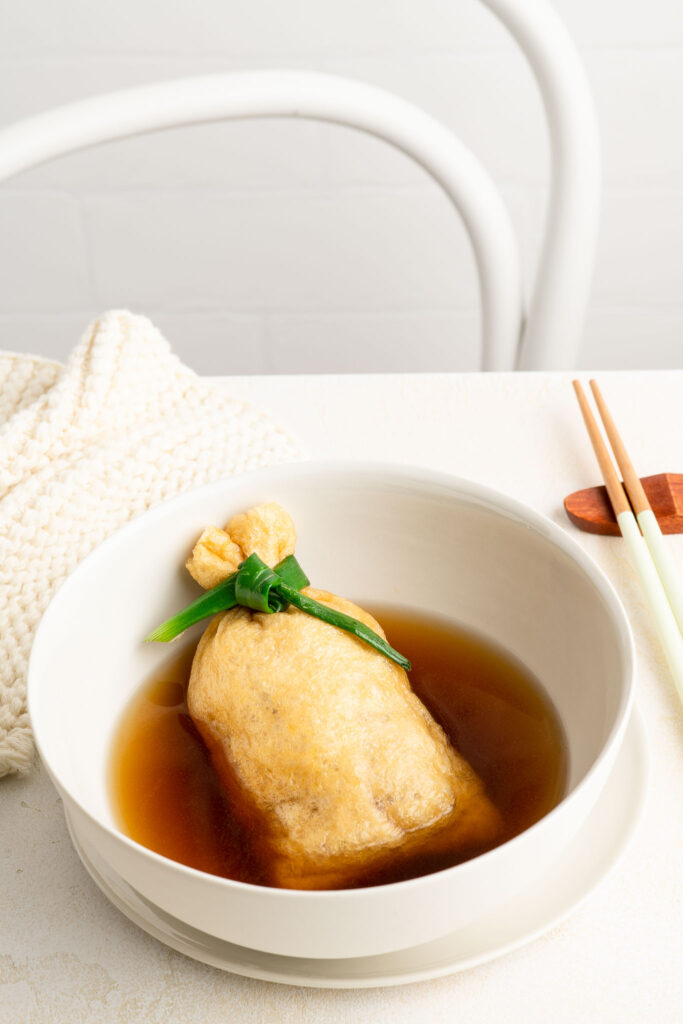Kitsune Udon with fried tofu pouches filled with udon noodles. Make this easy and delicious Japanese udon noodle soup with a fun twist!

Udon Noodle Soup
A simple Udon Noodle Soup is something I crave when I just want a bowl of thick, chewy noodles and a plain broth to sip on. When I was a uni student in Brisbane, my friends and I used to frequent a popular Japanese restaurant in the city for some cheap and cheerful lunches. They were some of my favourite times; we were so young and cash-strapped, but yet we ate like kings!
On days when I was particularly low on spending money (typically towards the end of the month), I always ordered something plain and simple like an Udon Noodle Soup, with no toppings whatsoever (I couldn’t afford it!), but the noodles and broth on their own were enough to sustain me. So even though I can afford all of the toppings now, I still think of this dish fondly as it reminds me how far I have come and how lucky I am to be where I am now ☺️
What is Kitsune Udon?
Kitsune Udon is a Japanese soup with udon noodles and topped with pieces of fried tofu.
Kitsune Udon means “fox udon” in Japanese, and the reference to fox is said to be because the fried tofu wedges resemble the fox’s ears.
I first became aware of Kitsune Udon on Instagram when the following reel caught my eye:
I was instantly mesmerised by the large tofu pouches in broth, which look delicious as they are, but when I saw that they were filled with udon noodles, I have been dreaming about this dish ever since!
This is such a fun take on Kitsune Udon and I have even bookmarked the restaurant for our upcoming visit to Japan!
Kitsune Udon Recipe
My recipe for Kitsune Udon is adapted from my recipe for Japanese Udon Noodle Soup. I make a simple dashi broth using dashi powder, which is the Japanese equivalent of using stock cubes.
When it comes to udon noodles, you can find them sold dried, vacuum-sealed, or frozen. I personally prefer to use frozen udon noodles as they have the best texture.

How to Make Kitsune Udon
What is, of course, essential to a Kitsune Udon are the large fried tofu pouches, called “Abura age” in Japanese. They taste much like deep-fried tofu puffs and have a spongey texture when cooked in a broth.
I came across them one day in the freezer section at my local Korean/Japanese grocer, and I instantly knew that I had to try and make Kitsune Udon. If you can find these tofu pouches where you live, try to find the largest size possible so that you can fit enough noodles for one serving.
If you can’t find these tofu pouches, you can make them yourself at home using large blocks of firm tofu. For more information, I would defer to Nami’s recipe at Just One Cookbook, a veteran blogger to whom I frequently turn to for inspiration on Japanese cuisine.

What to Serve with Kitsune Udon
Although I would happily eat Kitsune Udon as is, if I am making this for my family, I would typically add some vegetables in the dashi broth, such as corn, sliced carrots or courgettes, snow peas, or shitake mushrooms (you can add whatever vegetables you like!).
And to make the meal more substantial, I like to make my Homemade Popcorn Chicken to eat alongside. It’s very similar to Japanese Fried Chicken (Karaage), which I serve with Japanese Kewpie mayonnaise and Sriracha.
Print
Kitsune Udon
- Prep Time: 10 mins
- Cook Time: 20 mins
- Total Time: 30 minutes
- Yield: Serves 4
- Category: Dinner
- Method: Stove
- Cuisine: Japanese
Kitsune Udon with fried tofu pouches filled with udon noodles. Make this easy and delicious Japanese udon noodle soup with a fun twist!
Ingredients
For the Dashi Broth
- 2 litres (8 cups) water
- 2 x 8 g dashi powder
- 2–3 tablespoons soy sauce
- 1 tablespoon mirin
- 1 teaspoon sugar
- 1–2 teaspoons sea salt
For the Tofu Pouches
- 750 g (1.6 lb) frozen udon noodles
- 4 large fried tofu pouches (called “Abura age” in Japanese)
- spring onions (scallions)
Instructions
To Prepare the Dashi Broth
- In a large saucepan, bring the water to a gentle simmer.
- Add the dashi powder, soy sauce, mirin and sugar.
- Simmer the broth gently for about 5 to 10 minutes.
- Taste for seasoning. Add more salt or soy sauce if necessary, or you may need to dilute with more water if the broth is too strong or salty.
To Prepare the Noodles
- Fill a large saucepan with boiling water.
- Bring the saucepan to the boil on high heat.
- Add the noodles.
- Use a pair of tongs or chopsticks to gently loosen and separate the noodles. This step should take just a few seconds.
- Once the noodles have separated, drain the noodles immediately.
To Prepare the Tofu Pouches
- If the tofu pouches are frozen, defrost them at room temperature.
- Slice off a small piece at one end so that you can open the pouch.
- Gently open the pouch, taking care not to rip the tofu.
- Carefully fill the pouch with udon noodles, leaving enough room to seal the pouches later.
- Wash the spring onions (scallions), as they are easier to manoeuvre when they are wet.
- Use one sprig of spring onion (scallion) to tie a double knot at the top of each pouch.
To Serve
- Bring the dashi broth to a gentle simmer.
- Carefully place the stuffed tofu pouches in the broth.
- Simmer gently for about 5 minutes, which should be enough time to warm through the tofu and the noodles inside.
- Use a large slotted spoon to carefully remove a stuffed tofu pouch to a large bowl. Repeat with the remaining tofu pouches.
- Ladle some dashi broth over each tofu pouch.
- Serve immediately.
Kitchen Notes
 OVEN & STOVE TEMPERATURES
OVEN & STOVE TEMPERATURES
All recipes on this website have been tested on an induction stove and/or with a conventional oven (i.e. an oven without fan). All recipes on this website use temperatures for a conventional oven, unless otherwise mentioned. Convection ovens (i.e. fan-forced ovens) are typically 20°C/70°F hotter than conventional ovens, but please check your manufacturer’s handbook.
 CONVERSIONS
CONVERSIONS
To convert from cups to grams, and vice-versa, please see this handy Conversion Chart for Basic Ingredients.
 Print
Print Pin Recipe
Pin Recipe Rate
Rate
We went to this restaurant in Nara! I didn’t think of trying to make this dish at home until I saw your recipe the other day. Thank you so much for this recipe 🙏🏻 It was absolutely delicious and brought back great memories of our trip to Japan last year.